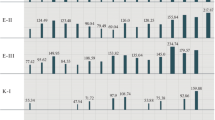A Drosophila population cage initiated with equal numbers of two viable II–III translocation homozygotes rapidly evolved into a balanced polymorphism with the two translocations maintained throughout 25 generations at which time the experiment was terminated. The fertility of this population averaged 26%; a control population averaged 90%. The establishment of the polymorphism was interpreted with reference to the reduced viability of the two homozygotes such that their net fitness was considerably less than that of partially sterile double heterozygote. By the incorporation of specific values for the relative fitness of the three genotypes in a computer programme it was possible to simulate the polymorphism.
Similar content being viewed by others
References
Bennett, J. (1956). Inexpensive population cages. Drosoph. Inf. Serv. 30: 159–160.
Callan, H.G. & H. Spurway (1951). A study of meiosis in interracial hybrids of the newt, Triturus cristatus. J. Genet. 50: 235–249.
Curtis, C.F. (1968a). Possible use of translocations to fix desirable genes in insect post populations. Nature 218: 368–369.
Curtis, C.F. & A.S. Robinson (1971). Computer simulation of the use of double translocations for pest control. Genetics 69: 97–113.
Darlington, C.D. (1936). The limitations of crossing-over in Oenothera. J. Genet. 32: 343–352.
Dobzhansky, T. & A. Dreyfus (1943). Chromosomal aberrations in Brazilian Drosophila ananassae. Proc. natn. Acad. Sci. U.S.A. 24: 301–305.
Frydenberg, O. (1962). Estimation of some genetical and vital statistics parameters of Bennett populations of D. melanogaster. Hereditas 48: 83–104.
Gopinath, D.M. & C.R. Burnham (1956). A cytogenetic study in maize of deficiency — duplication produced by crossing interchanges involving the same chromosome. Genetics: 41: 382–395.
Hossain, M.A., C.F. Curtis & W.P. Jaffe (1974). Selection on the fertility of translocation heterozygotes in Drosophila melanogaster 1. the extent of changes produced by selection. J. Genet. 61: 205–217.
John, B. & K.R. Lewis (1958). Studies on Periplaneta americana III Selection for heterozygosity. Heredity 12: 185–197.
Li, C.C. (1955). Population Genetics. Univ. Chicago Press.
Lewis, K.R. & B. John (1957). Studies on Periplaneta americana. Interchange heterozygosity in isolated populations. Heredity 11: 11–22.
McDonald, P.T. & K.S. Rai (1971). Population control potential of heterozygous translocations as determined by computer simulations. Bull. Wld Hlth Orgn 44: 829–845.
Robinson, A.S. & C.F. Curtis (1972). Crossing-over in a double translocation in Drosophila. Can. J. Genet. Cytol. 14: 129–137.
Robinson, A.S. & C.F. Curtis (1973). Controlled crosses and cage experiments with a translocation in Drosophila. Genetica: 44: 591–601.
Rai, K.S., N. Lorimer & S. Hallinan (1974). The current status of genetic methods for controlling Aedes aegypti. In: The Use of Genetics in Insect Control. Eds. R. Pal & M.J. Whitten, North Holland, pp. 119–132.
Sakai, R.K., R.H. Baker, A. Mian & S. Said (1972). Sterility enhancement in the mosquito, Culex tritaeniorhynchus, Can. J. Genet. Cytol. 14: 215–220.
Serebrovskii, A.S. (1940). On the possibility of a new method for the control of insect pests. Zool. Zh. 19: 618–630 (in Russian).
Spurway, H. & H.G. Callan (1960). The vigour and male sterility of hybrids between the species Triturus vulgaris and T. helvetieus. J. Genet. 57: 84–117.
Uppal, D.K., C.F. Curtis & K. Rai (1974). A double translocation heterozygote in Aedes aegypti. J. Comm. Dis. 6: 98–101.
Wagoner, D.E., I.C. McDonald & D.C. Childress (1974). The present status of genetic control mechanisms in the house fly, Musca domestica. In: The Use of Genetics in Insect Control. Eds. R. Pal & M.J. Whitten, North Holland, pp. 183–197.
Whitten, M.J. (1971). Use of chromosome rearrangements for mosquito control. pp. 399–413. In: Sterility principle for insect control or eradication, I.A.E.A., Vienna.
Wright, S. (1941). On the probability of fixation of reciprocal translocations. Am. Nat. 75: 513–522.
Author information
Authors and Affiliations
Rights and permissions
About this article
Cite this article
Robinson, A.S. Translocations and a balanced polymorphism in a Drosophila population. Genetica 47, 231–236 (1977). https://doi.org/10.1007/BF00123244
Received:
Accepted:
Issue Date:
DOI: https://doi.org/10.1007/BF00123244




